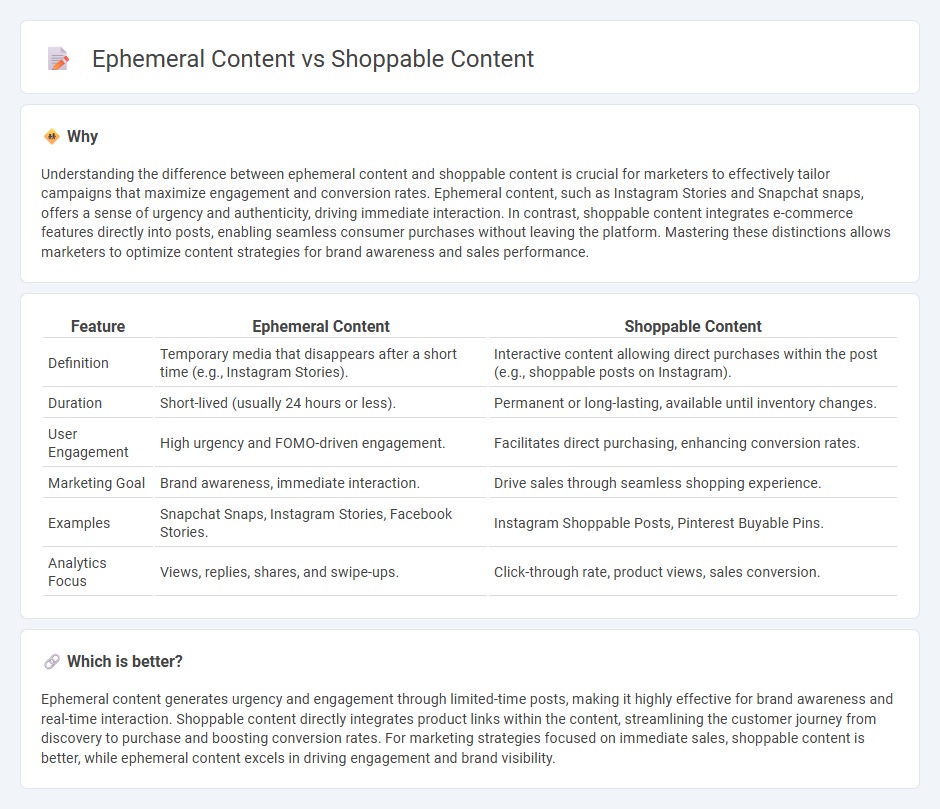
Ephemeral content drives urgency through short-lived posts on platforms like Instagram Stories, boosting real-time engagement and brand visibility. Shoppable content integrates direct purchasing options within social media, streamlining the customer journey from discovery to conversion. Explore how these dynamic marketing strategies can elevate your brand's digital presence and sales.
Why it is important
Understanding the difference between ephemeral content and shoppable content is crucial for marketers to effectively tailor campaigns that maximize engagement and conversion rates. Ephemeral content, such as Instagram Stories and Snapchat snaps, offers a sense of urgency and authenticity, driving immediate interaction. In contrast, shoppable content integrates e-commerce features directly into posts, enabling seamless consumer purchases without leaving the platform. Mastering these distinctions allows marketers to optimize content strategies for brand awareness and sales performance.
Comparison Table
| Feature | Ephemeral Content | Shoppable Content |
|---|---|---|
| Definition | Temporary media that disappears after a short time (e.g., Instagram Stories). | Interactive content allowing direct purchases within the post (e.g., shoppable posts on Instagram). |
| Duration | Short-lived (usually 24 hours or less). | Permanent or long-lasting, available until inventory changes. |
| User Engagement | High urgency and FOMO-driven engagement. | Facilitates direct purchasing, enhancing conversion rates. |
| Marketing Goal | Brand awareness, immediate interaction. | Drive sales through seamless shopping experience. |
| Examples | Snapchat Snaps, Instagram Stories, Facebook Stories. | Instagram Shoppable Posts, Pinterest Buyable Pins. |
| Analytics Focus | Views, replies, shares, and swipe-ups. | Click-through rate, product views, sales conversion. |
Which is better?
Ephemeral content generates urgency and engagement through limited-time posts, making it highly effective for brand awareness and real-time interaction. Shoppable content directly integrates product links within the content, streamlining the customer journey from discovery to purchase and boosting conversion rates. For marketing strategies focused on immediate sales, shoppable content is better, while ephemeral content excels in driving engagement and brand visibility.
Connection
Ephemeral content boosts engagement by creating urgency and exclusivity, which enhances the effectiveness of shoppable content by driving immediate purchasing decisions. Integrating shoppable features into ephemeral formats like stories or reels leverages consumers' impulsive behavior, increasing conversion rates. Brands use this synergy to maximize real-time interaction, blending fleeting attention spans with seamless shopping experiences.
Key Terms
**Shoppable Content:**
Shoppable content integrates direct purchasing options within digital media, enhancing user experience by allowing immediate transactions through interactive images, videos, or posts. Brands leveraging shoppable content boost conversion rates by seamlessly blending advertising and shopping, particularly on platforms like Instagram and TikTok. Explore how shoppable content can transform your e-commerce strategy and drive sales growth effectively.
Conversion
Shoppable content integrates product links directly into engaging media, boosting conversion rates by simplifying the purchase process and reducing friction for consumers. Ephemeral content, such as Stories or Snapshots, creates urgency and exclusivity that can drive immediate action but often has a limited lifespan to influence purchasing decisions. Explore detailed strategies to leverage both content types for maximized conversion impact.
Product Tagging
Product tagging in shoppable content enables seamless purchasing by embedding direct links to products within images or videos, driving higher conversion rates through instant customer engagement. Ephemeral content, such as Stories on social media, leverages product tagging to create urgency and exclusivity, capitalizing on limited-time visibility to boost sales. Explore how integrating product tagging strategies in both formats can maximize your e-commerce effectiveness.
Source and External Links
Shopify Blog: 7 Effective Types of Shoppable Content To Boost Digital - Shoppable content includes interactive media like photos, videos, blog posts, and social content that let users purchase products directly from the content, spanning formats such as shoppable social posts, images, videos, livestreams, articles, ads, and gift guides.
Storyly: What is Shoppable Content? Benefits, Types & Examples - Shoppable content is any digital content with integrated purchasing capabilities, allowing consumers to buy items directly within the content without navigating to a separate shopping page, streamlining the buying process and increasing impulse purchases.
Flowbox: What is Shoppable Content: Benefits, Types, and Strategies - Shoppable content refers to any content--social post, video, image, or blog--that enables direct, real-time purchases while consumers are engaged with the content, often including embedded shoppable links within user-generated posts to showcase authentic product experiences and drive sales.
 dowidth.com
dowidth.com